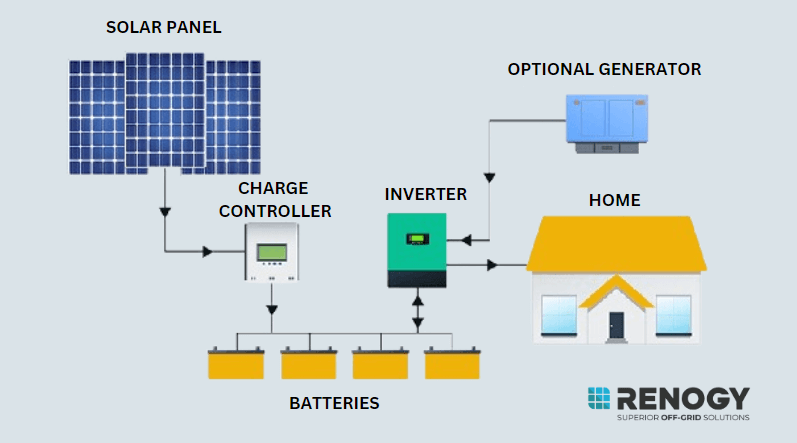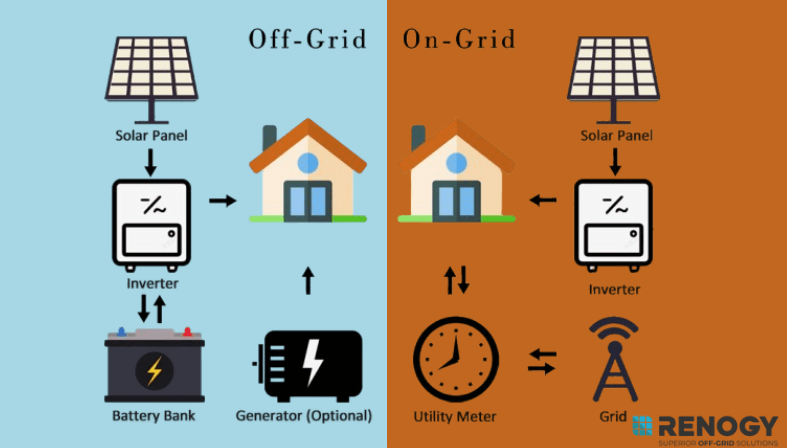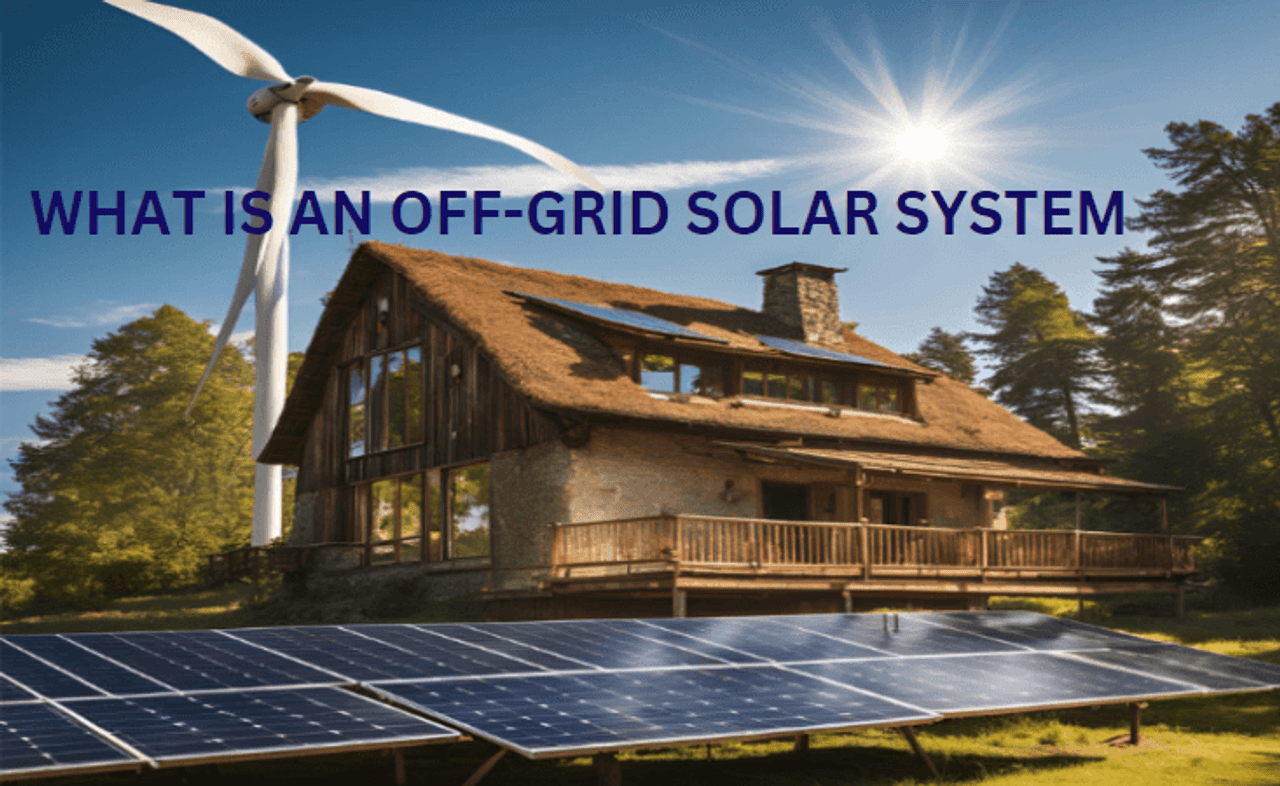What is an Off-Grid Solar System?
Depending on solar energy, wholly as part of off-grid living is rapidly gaining traction among people who are seeking freedom and want to live sustainably.
With an off-grid system installation, you no longer depend on electricity companies or the government for power supply. Have you been envisioning the big shift to off-grid solar? Keep reading to understand what it entails, its benefits, and its drawbacks, among other factors.
What Is an Off-Grid Solar System?
For a long time, most people have been dependent on utility companies and the government for energy provision. However, now with the off-grid solar system you don’t have to depend on the grid system for electricity supply.
The off-grid solar system allows you to generate your electricity by harnessing the sunlight. Therefore, an off-grid solar system works independently from the grid system to generate power for homes, businesses, RVs, and institutions.
More people are embracing the off-grid solar system to become energy-independent, reduce their carbon footprint, and minimize or eliminate electricity costs in the long run.
An off-grid solar system utilizes photovoltaic (PV) panels to charge the power storage systems, i.e. the batteries and solar generators.
An effective off-grid solar system must be able to provide electricity continually at night, during cloudy days, and in winter.

Parts of an Off-Grid System
An off-grid solar system is composed of four key essentials, i.e. the solar panels, battery, charge controller, and inverter. All four elements are configured to work in harmony for an efficient off-grid system.
Solar Panels
Solar panels or photovoltaic modules are the primary factors of a solar system. When hit by the sun, the solar panel cells produce DC (Direct Current). The DC is then changed into usable AC (Alternating Current), which is then used for lighting and powering appliances.
Solar Batteries
Shifting to off-grid living demands a robust power storage system, i.e. the batteries. Your storage system must be large to store enough power to keep you powered during the night and on cloudy days.
Solar Charge Controllers
The charge controller is tasked to standardize electricity voltage and current from the solar panel to the battery. It prevents the battery from getting damaged by excessive current.
There are two categories of charge controllers, the PWM (Pulse-width modulation) and the MPPT (maximum power point tracking). With PWM, the solar panels and batteries' voltage must match. In MPPT, you can charge a battery with a higher-voltage solar panel.
Inverters
The solar panels produce and batteries store electricity in DC form. Home appliances require AC electricity to operate. Therefore, the role of an inverter is to convert the DC electricity to usable AC electricity.
How Does an Off-Grid Solar System Work?
As stated above, the off-grid solar system comprises four elements, solar panels, inverter, charge controller, and batteries.
The solar panels are positioned in an open place or at the rooftop. They receive sun rays, which are then transformed into electricity. The solar charge controller transforms the electricity from DC to AC. If the electricity is generated in excess or unused, it is stored in the battery.
Here’s a step-by-step breakdown of how an off-grid solar system works:
- Solar Panels- Solar panels are fitted with solar cells that harness sunlight and convert it to solar energy.
- Solar Charge Controller- The charge controller is responsible for regulating batteries to prevent damage due to overcharging.
- Batteries- The yielded excess energy is stored in the solar batteries for future use.
- Inverter- The role of an inverter is to convert DC to AC electricity for powering appliances and charging devices.
Pros and Cons of an Off-Grid Solar System
Here are some advantages and setbacks of an off-grid solar system.
Pros
- Independence from the Grid- off-grid solar system gives you energy independence from utility systems.
- Low Carbon Emissions- Burning fossil fuels releases toxic fumes to the environment, which harms the ozone and adversely impacts the climate. Embracing solar energy as renewable and clean energy reduces low carbon emissions and helps in preventing and combating adverse climate change.
- Cost-effective- Saves your costs in the long run by reducing costly utility bills and costs of fuel.
Cons
- Setting up an off-grid solar system is expensive.
- You must adjust your lifestyle to fit into the off-grid living.
What Is an On-Grid Solar System?
The on-grid solar system or the grid-tied system refers to a system where you get electricity supply from an electric grid, usually provided by a utility company. The on-grid system provides a reliable source of power.
In most cases, homes and businesses integrate the on-grid system with an off-grid system, allowing them power access when the off-grid solar system cannot generate adequate power.
With the grid-tied systems, you can benefit from net metering, which involves channeling excess solar power back to the grid, thus minimizing your electricity bills.

Differences Between Off-Grid and On-Grid Solar Systems
1. Electricity Access
Off-Grid Systems: With an off-grid system, you 100% rely on the sun to generate electricity. If there is surplus electricity, you can store it in the batteries for future use. The electricity generated and stored is all you can rely on in an off-grid solar system.
On-Grid Systems: With an on-grid system, you can access electricity all the time, unless the grid system is down. If your off-grid system is not producing enough power, you can incorporate an on-grid system to supplement it.
2. Surplus Electricity
If you have a relatively large off-grid system, you can generate more electricity than you can consume. Having a robust storage system is crucial for the storage the surplus electricity for future use.
However, most off-grid systems are designed to generate a certain amount of electricity in a day. Even though the systems are designed to be accurate, the weather may sometimes be unpredictable. There are days when the solar panels cannot generate electricity and the storage system is depleted. During these times, you can fall back on alternative sources such as on-grid systems.
If you are connected to the on-grid system, excess electricity is not channeled to the batteries like in off-grid systems. The surplus electricity is reversed back to the grid. Then you are compensated for the excess energy.
The system through which you can channel the excess electricity to the grid is referred to as net metering.
In the US, net metering operates by compensating you with credits for the amount of electricity you have sent to the grid.
3. The Grid Down Time
Even during electricity cut-off due to bad weather or storms, your off-grid solar system will continue operating because it is independent of the grid system. The stored electricity comes in handy. You will not suffer loss of electricity.
On-grid solar systems may occasionally experience some downtime. During these downtimes, you will have no access to power. The solution is to have a battery for electricity backup during downtimes.
4. Electricity Bills
With an off-grid system, your electricity bills will be non-existent. Although off-grid solar systems will save you costs in the long run, you should understand that the initial installation costs are high.
You will pay electricity bills if you opt for a grid-tied system.
Renogy Off Grid Solar System
The Renogy off-grid solar system kit is compact and smart. The system is easy to set up on your house or RV.
It features four ultra-flexible 200-watt (W) monocrystalline panels with an 800w output. With just 5 hours of ample sunlight, the panels can generate a whopping 3.5 to 4kWh a day.
Also, the kit includes a charge controller, a 3000w pure sine wave inverter, an adapter kit, brackets, and connectors. Additionally, it features a 60A MPPT charge controller with built-in protection against overloading, overcharging, and damage.
However, the battery comes separately. Other accessories that come with the kit include cables, mounts, and a monitoring system. The Renogy off-grid solar kit is suitable for homes, campsites, RVs, and boats.
Conclusion
An off-grid solar system is a standalone electricity solution that does not depend on the conventional grid. It is a sustainable option in the long run, minimizes carbon footprint, and saves you money. If you are ready to live autonomously as you promote the global agenda of eco-living, an off-grid solar system is an excellent option.
Frequently Asked Questions
1. How many solar watts do I need for an off-grid solar system?
That will depend on your energy consumption rate. However, you need about 3-10Kw. Bigger homes may need higher watts up to 10-15 Kw.
2. Is it possible to run an off-grid system without a battery?
Yes, it is possible. Although a battery is necessary, it is not mandatory. However, you can only access electricity when the sun is up. A storage system, such as a battery ensures that you will continue enjoying power even at night or on cloudy days.
3. What is a hybrid solar system?
The hybrid solar system is connected to the grid and still features a battery for electricity storage, thus giving the user more flexibility.











